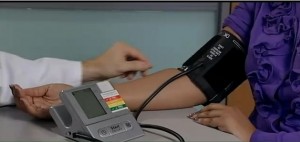 Harvard Medical School has recently issued a new HealthBeat report, published by Harvard Health Publications, with practical tips on how to measure your blood pressure at home.
Harvard Medical School has recently issued a new HealthBeat report, published by Harvard Health Publications, with practical tips on how to measure your blood pressure at home.
“Checking blood pressure at home won’t cure hypertension, but it will help control the most common cause of stroke and a big contributor to heart attack, heart failure, and premature death,” according to the new Harvard HealthBeat report. But it is important to do it correctly, in order to get a correct reading.
What is Normal Blood Pressure?
According to the National Heart, Lung & Blood Institute, part of the National Institutes of Health (NIH):
You most often will see blood pressure numbers written with the systolic number above or before the diastolic number, such as 120/80 mmHg. (The mmHg is millimeters of mercury—the units used to measure blood pressure.)”
A blood pressure chart presented by the National Heart Lung & Blood Institute, indicates that for adults 18 years old and older, who do not have short term serious illnesses:
- Normal blood pressure – means a Systolic (top) number less than 120, AND a Diastolic (bottom) number less than 80;
- Prehypertension – is indicated by a Systolic (top) number of 120–139 OR a Diastolic (bottom) number of 80–89;
- Stage 1 High Blood Pressure – is indicated by a Systolic (top) number of 140–159 OR a Diastolic (bottom) number of 90–99; and
- Stage 2 High Blood Pressure – is indicated by a Systolic (top) number of 160 or higher OR a Diastolic (bottom) number of 100 or higher.
To keep your blood pressure normal, it is important to reduce salt intake and take the steps recommended by your doctor to prevent or treat high blood pressure.
In addition, it is important to regularly monitor your own blood pressure, and to know how to do so correctly at home. Here are some of the practical tips on how to do so presented by the new Harvard HealthBeat report:
Selecting a Blood Pressure Monitor
Harvard recommends, “For best accuracy and ease of use, buy [a blood pressure monitor] with a cuff for the upper arm that automatically inflates and automatically records the pressure.” “The American Heart Association doesn’t recommend wrist or finger home blood pressure monitors,” they point out. They do suggest that “Models that store readings for a week or two can simplify record keeping.”
According to the Harvard report, Consumer Reports compared blood pressure monitors in its September 2008 issue, and rated the ReliOn HEM-74CREL ($50) with a “best buy” rating, while the Omron Elite 7300W ($75 to $100) was the top-rated machine.
A new report has been issued by Consumer Reports in September, 2011, in which they state that “[Consumer Reports'] most recent tests (available to subscribers) of 19 blood-pressure monitors found 13 that are worth recommending (available to subscribers).
How to Take Your Blood Pressure At Home
“When it comes to measuring blood pressure, technique matters. Doing it wrong can give you a reading that’s too high or too low,” the Harvard report states.
Before your start, the Harvard authors advise that you “check your machine against the one in your doctor’s office.” They also advise making sure that the cuff of your machine is the right size for you. “The inflatable part should encircle at least 80% of your upper arm,” the authors state.
Techniques; How to Do It Correctly
Here are some of the techniques for correctly taking your blood pressure at home advised by the Harvard report:
- “To get the most accurate blood pressure reading, support your arm at heart level, wrap the cuff around your bare upper arm, and follow the directions on your machine.”
- “When you first start to check your blood pressure at home, measure it early in the morning, before you have taken your blood pressure pills, and again in the evening, every day for a week. After that, follow the plan your doctor recommends, or check it one or two days a month.”
- “Each time you take a reading:
- Avoid caffeinated or alcoholic beverages, and don’t smoke, during the 30 minutes before the test.
- Sit quietly for five minutes with your back supported and feet on the floor.
- When taking the measurement, support your arm so your elbow is at the level of your heart.
- Push your sleeves out of the way and wrap the cuff over bare skin. Measure your blood pressure according to the machine’s instructions.
- Leave the deflated cuff in place, wait a minute, then take a second reading. If the readings are close, average them. If not, repeat again and average the three readings.
- Don’t panic if a reading is high. Relax for a few minutes and try again.
- Keep a record of your blood pressure readings and the time of day they are taken.”
The new Harvard HealthBeat Report on How to Measure Your Blood Pressure At Home, is available online from Harvard Health Publications.
More Information
See also this instructional video sponsored by the American College of Physicians, and presented by Doron Schneider M.D. » How to Take Your Own Blood Pressure.
And see the HelpingYouCare™ resource pages on High Blood Pressure, including:
- Latest News on High Blood Pressure;
- What is is; Causes;
- Symptoms & Diagnosis;
- Prevention;
- Treatment;
- Caregiving.
_____________
Copyright © 2011 Care-Help LLC, publisher of HelpingYouCare™.












In the study that included 1,700 teens between the ages of 13 and 17, obese girls had three times the risk of higher blood pressure. http://bit.ly/p2qGY2